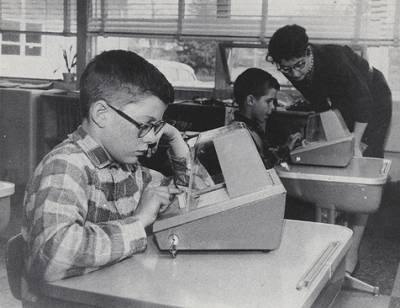Table of Contents
Programmed Instruction
General
Although first ideas on instruction automation can be tracked to even earlier years1), first notable steps in programmed instruction were taken by Sidney Pressey2) in the 1920s and further developed by Burrhus Skinner in the mid-1950s. In Pressey's words, the teacher is
- “… burdened by such routine of drill and information-fixing…”, but a mechanical device device could be used to “lift from her shoulders as much as possible of this burden and make her free for those inspirational and thought-stimulating activities which are, presumably, the real function of the teacher.”3)
What is programmed instruction?
Pressey's ideas were not so well received in the public and due to a lack of financial means he soon had to give up further research, yet in the 1950s his ideas were further developed by Skinner, who believed he can successfully apply operant conditioning not only to animal, but also to human learning.
Skinner's ideas for improving the teaching/learning process were orientated mostly on two facts: first, that learners learn at different speeds, and second, that, in accordance with at the time dominant stimulus-response learning theories, the reinforcement must closely follow the displayed behavior.
This, however is not the case in school settings, where the learners are forced to follow the lecturers speed of information sharing and usually receive delayed reinforcement as the teacher usually needs at least a day to correct their assignments. According to Skinner, in order to achieve efficient mathematical behavior, during the first four years of education, about 50000 reinforcements would be necessary, but in a classroom situation a learner could only get a few thousands of them. In Skinner's words,
- “The simple fact is that, as a mere reinforcing mechanism, the teacher is out of date.”4)
Since employing a teacher or tutor for every learner would solve the problem, but would be virtually impossible, Skinner suggested and worked on introducing learning machines, on which each learner could work at his own pace and receive direct reinforcement after solving a task correctly.
The basic principle of programmed instruction for Skinner, aside from reinforcement was behavior shaping - forming desired behavior through a number of small stimulus-response learning sessions.5)
- “By making each successive step as small as possible, the frequency of reinforcement can be raised to a maximum, while the possibly aversive consequences of being wrong are reduced to a minimum.”6)
What is the practical meaning of programmed instruction?
Learning from programmed instruction on a learning machine usually includes:
- a carefully designed course with predefined sequence of units,
- very small units delivering only a small amount of new information so it is easily understandable (shaping),
- immediate answer after filling in the missing information (reinforcement)
- moving on to the next unit based on the correctness of the given answer.
Criticisms
Various criticisms of programmed instruction proposed so far object programmed instruction method for7):
- assigning the responsibility for learning to the learning materials and not to learners (ontological determinism),
- forcing instructional problems to fit into observable behavior measuring and accepting only observable behaviors as proper learning outcomes (materialism),
- presenting technology as the key factor for learning without addressing learner's needs (technological determinism)
- rigidness and resistance to adaptation to fit individual learner's needs, and
- ensuring that learners are correct as often as possible through shaping (overprompting).
Research has provided questionable results about the efficiency of the programmed instruction and learning machines. A meta-study8), that summarized results of 36 studies comparing programmed instruction with traditional classroom teaching suggested 18 of 36 showed no statistically significant difference, 17 showed a statistically significant difference in favor of programmed instruction and one study showed a statistically significant difference in favor of classroom teaching.
Other research found that programmed instruction can result in frustration if a learner can't follow the pace of his peers, paying less attention due to overprompting and eventually disliking the concept of programmed instruction.9)
There still is an ongoing yet limited research today examining benefits of programmed instruction as an addition to learning materials.10)
Keywords and most important names
- Programmed instruction, learning machine, shaping, reinforcement, overprompting
Bibliography
Wleklinski, Nichole. Skinner’s Teaching Machine and Programmed Learning Theory. Retrieved July 15, 2011.
Read more
Schramm, W. The Research on Programmed Learning: an annotated bibliography. Washington, D.C.: U.S. Department of Health, Education and Welfare, 1964.
Pressey, S. L. A simple apparatus which gives tests and scores - and teaches. School and Society 23, no. 586: 373-376. 1926.
